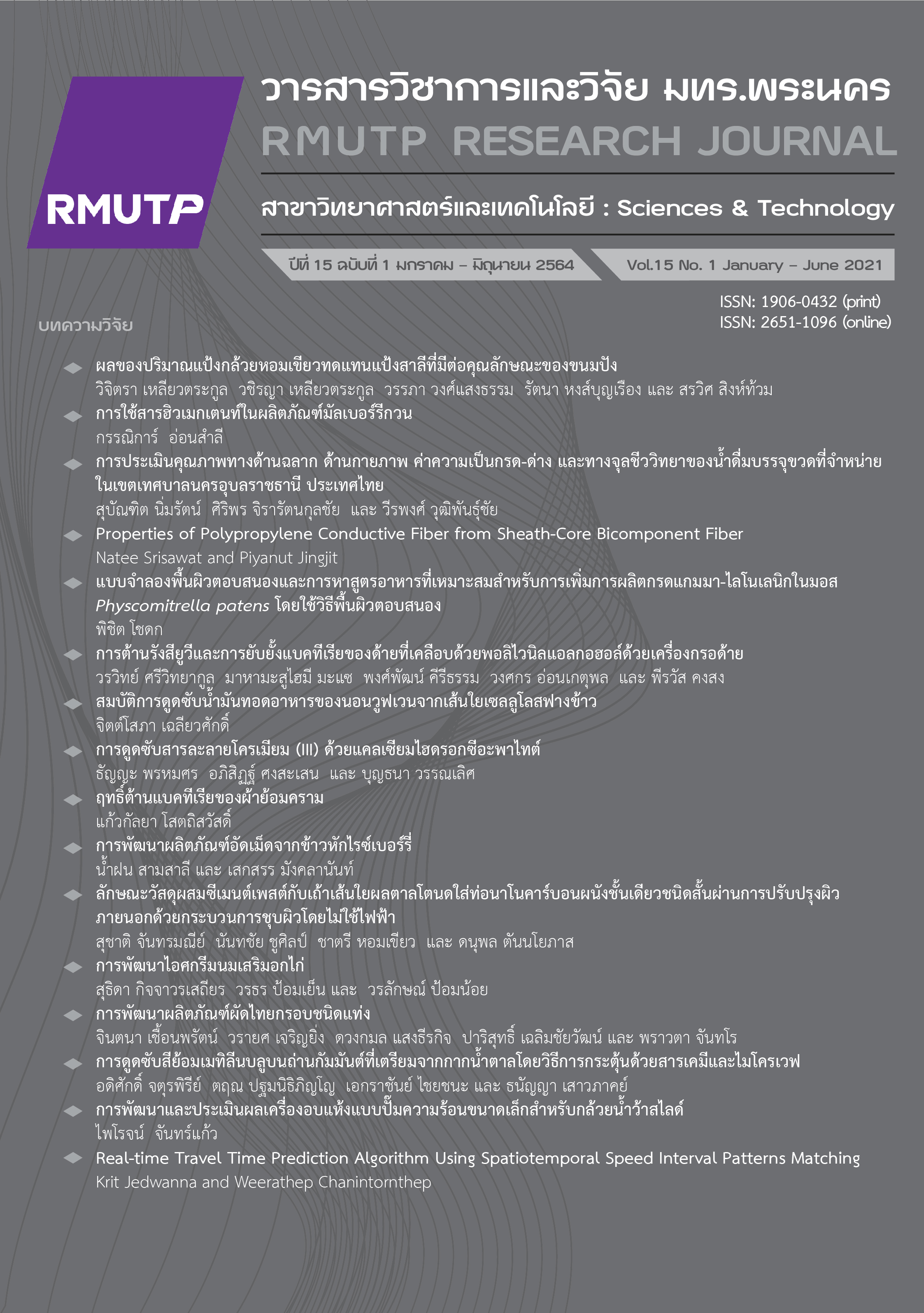การต้านรังสียูวีและการยับยั้งแบคทีเรียของด้ายที่เคลือบด้วยพอลิไวนิลแอลกอฮอล์ด้วยเครื่องกรอด้าย
Main Article Content
บทคัดย่อ
วัตถุประสงค์ของการศึกษาในครั้งนี้เพื่อพัฒนาสมบัติการต้านรังสียูวีและยับยั้งแบคทีเรียของด้ายเพื่อให้ได้สิ่งทอที่มีคุณภาพ โดยนำด้ายมาเคลือบด้วย โซเดียมไดไฮโดรเจนฟอสเฟต แมกนีเซียมคลอไรด์ น้ำยาปรับผ้านุ่ม และพอลิไวนิลแอลกอฮอล์ปริมาณตั้งแต่ 0 ถึง 0.54 โมลาร์ ด้วยเครื่องกรอด้าย ศึกษาลักษณะเส้นด้ายเครื่องจุลทรรศน์อิเล็กตรอนแบบส่องกราดชนิดฟิลด์อิมิสชัน วิเคราะห์องค์ประกอบทางเคมีด้วยเทคนิคฟูเรียร์ทรานส์ฟอร์มอินฟราเรดสเปกโตรสโคปี และวัดค่าการส่องผ่านแสงด้วยเครื่องวัดค่าการดูดกลืนแสง ซึ่งผลการป้องกันรังสียูวีของการเคลือบได้ผลดีมาก ผลของการยับยั้งแบคทีเรียของด้ายเคลือบพอลิไวนิลแอลกอฮอล์ที่ความเข้มข้น 0.45 โมลาร์ สามารถยับยั้งแบคทีเรีย สแตปฟิโลคอคคัส ออเรียส และ เอสเชอริเชีย โคไล ได้สูงถึงร้อยละ 87 และ 91 ตามลำดับ ซึ่งคาดว่าผลการวิจัยสามารถที่จะพัฒนาไปในทางที่เกิดการประยุกต์ใช้ทางด้านการเพิ่มประสิทธิภาพของผ้าและนวัตกรรมด้านอุตสาหกรรมสิ่งทอ
Article Details
เอกสารอ้างอิง
C. W. Kan, “A Study on Ultraviolet protection of 100% cotton knitted fabric: Effect of fabric parameters,” The Scientific World Journal, vol. 2014, pp. 1-10, 2014.
P. D. Dubrovski, Woven fabric engineering: Woven fabrics and ultraviolet protection, 1 st ed. BoD–Books on Demand, 2010.
A.Sivakumar, R. Murugan, K. Sundaresan and S. Periyasamy, “UV protection and self-cleaning finish for cotton fabric using metal oxide nanoparticles,” Indian journal of Fibre and Textile Research, vol. 38, no. 3, pp. 285-292, 2013.
M. Masae, L. Wanapong, L. Sikong, P. Choopool and P. Kongsong, “Hydrophobic and antibacterial activity of silk textile surfaces using reduced graphene oxide (rGO) and TiO2 coating,” Journal of Materials Science and Applied Energy, vol. 7, no. 3, pp. 307-316, 2018.
M. Masae, P. Pitsuwan, T. Sriwang, S. Sukwisut and P. Choopool, “Hydropho bicity and antibacterial activity of coated cotton fabrics with chitosan, TiO2 and SiO2,” Journal of Science and Technology, vol. 11, no. 21, pp. 165-178, 2019.
M. Periolatto, F. Ferrero, C. Vineis, A. Varesano and G. Gozzelino, “Novel Anti microbial Agents and Processes for Textile Applications,” Antibacterial Agents, vol. 17, 2017.
M. D. Zahidul Islam, “Effect of Winding Speed on Yarn Properties, Journal of Engineering Research and Application, vol. 9, no. 3, pp. 28-34, 2019.
M. Shanbeh, B. Baghaei, S. Alidadi and A. Tabibi, “Coating of Core Yarn. An Alter native Method of Decreasing the Strip-back Phenomenon of Core-spun Yarns,” Fibres & Textiles in Eastern Europe, vol. 19, no. 5, pp. 28-32, 2011.
Z. Yildiz, I. Usta and A. Gungor, “Investigation of the electrical properties and electromagnetic shielding effective ness of polypyrrole coated cotton yarns,” Fibres & Textiles in Eastern Europe, vol. 2, no. 98, pp. 32-37, 2013.
G. Daniele, B. Laura, D. L. Sara, P. Patrizia, S. Arianna, C. Francesca, S. Francesco, Z. Gaetano and R. Annalisa, “UV protective properties of cotton and flax fabrics dyed with multifunctional plant extracts,” Dyes and Pigments, vol. 105, pp. 89-96, 2014.
W. Sriwittayakul, T. Rungrodejanarueti, T. Srimuni, M. Masae and P. Choopool, “Antibacterial activity and solar UV-pro tective properties of cotton dyed with natural dye compared with commercial yellow robe,” RMUTI JOURNAL Science and Technology, vol. 12, no. 1, pp. 27-41, 2019.
F. Ruipérez, J. I. Mujika, J. M. Ugalde, C. Exley and X. Lopez, “Pro-oxidant activity of aluminum: promoting the Fenton reaction by reducing Fe (III) to Fe (II),” Journal of Inorganic Biochemistry, vol. 117, pp. 118-123, 2012.
F. S. Ghaheh, S. M. Mortazavi, F. Alihosseini, A. Fassihi, A. S. Nateri and D. Abedi, “Assessment of antibacterial activity of wool fabrics dyed with natural dyes,” Journal of Cleaner Production, vol. 72, pp. 139-45, 2014.
R. J. Lambert and M. Stratford, “Weak-acid preservatives: modelling microbial inhibition and response,” Journal of Applied Microbiology, vol. 86, no. 1, pp. 157-164, 1999.
P. O. Alarcón, K. Sossa, D. Contreras, H. Urrutia and A. Nocker, Antimicrobial properties of magnesium chloride at low pH in the presence of anionic bases,” Magnesium Research, vol. 27, no. 2, pp. 57-68, 2014.
P. Garside and P. Wyeth, “Identification of cellulosic fibres by FTIR spectroscopy-thread and single fibre analysis by attenuated total reflectance,” Studies in conservation, vol. 48, no. 4, pp. 269-275, 2003.
A. Kharazmi, N. Faraji, R. M. Hussin, E. Saion, W .M. Yunus and K. Behzad, “Structural, optical, opto-thermal and thermal properties of ZnS-PVA nanofluids syn thesized through a radiolytic approach,” Beilstein Journal of Nanotechnology, vol. 6, no. 1, pp. 529-536, 2015.
Y. Liu, C. Xiao, X. Li, L. Li, X. Ren, J. Liang and T. S. Huang, “Antibacterial efficacy of functionalized silk fabrics by radical copolymerization with quaternary ammonium salts,” Journal of Applied Polymer Science, vol. 133, no. 21, pp. 43450, 2016.


